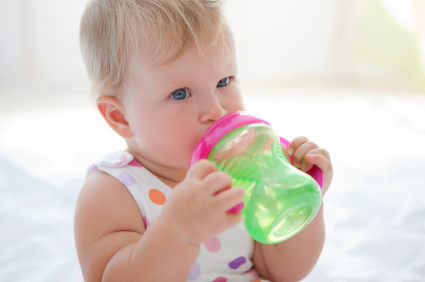Some parents have found that their exclusively breastfed baby will begin to refuse the bottle around three-four months of age. In some cases, babies will accept sippy cups instead, providing parents with a convenient alternative to breastfeeding when on-the-go or in public. While this is not always the case, if you find your baby refusing the bottle, consider introducing the sippy cup at that time as a potential bottle alternative.
Introducing Sippy Cup: What the Experts Say
The ADA recommends using a sippy cup that is not a “no-spill” cup. Per the Association, “no-spill” cups have valve beneath the spout which stop spills ““ however, in doing so, it prevents babies from actively sipping and requires them to suck as they would from a bottle; this defeats the purpose of a sippy cup.

When transitioning to a sippy cup with a young infant, you may ease the transition ““ and protect your furniture ““ by first using a no-spill cup. However, once your baby has the proper hand-eye coordination and has accepted this new method of drinking, you should likely consider moving into compliance with the ADA’s recommendation.
As with most baby-related guidance, the best guidance is to follow your own intuition and your baby’s lead. As long as your little one can support his/her head, sit in a high chair or with support, and reliably bring things to his/her mouth, you can consider introducing the sippy cup. However, if you prefer to wait, it is perfectly ok to do so as long as you introduce it before one year of age.